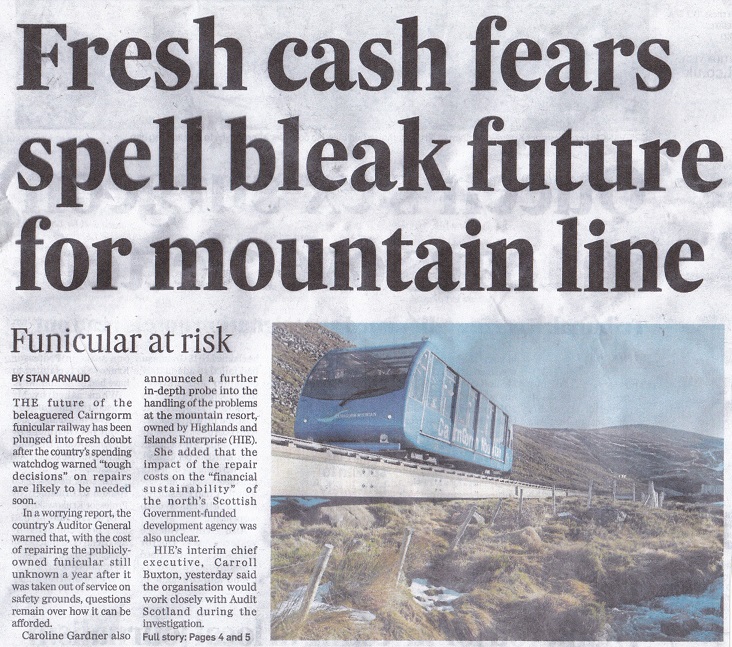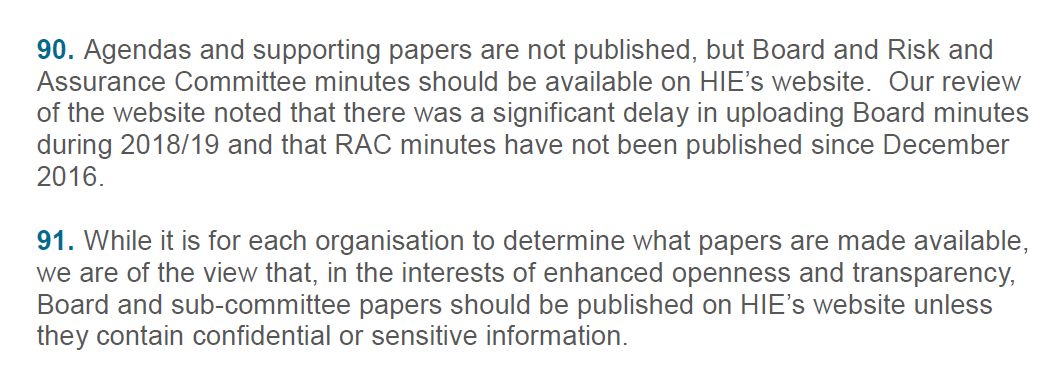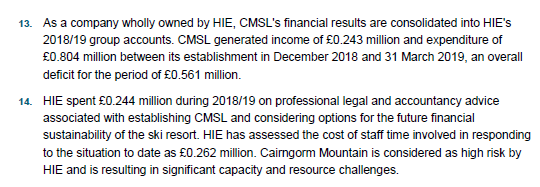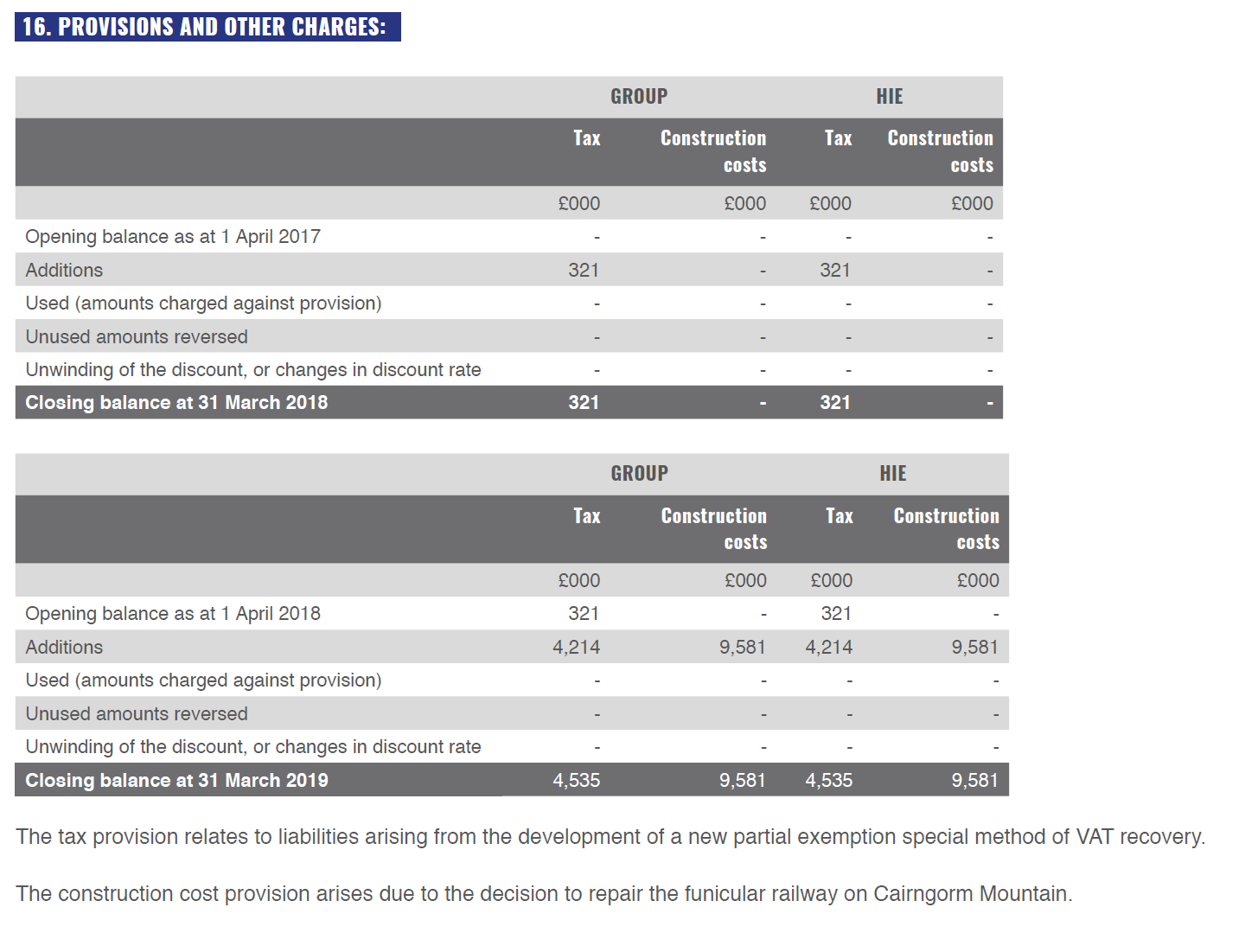
Last week Audit Scotland, who are responsible for overseeing financial management by public authorities, published their annual audit of Highlands and Islands Enterprise (to March 2019) and a supplementary report “Cairngorm Mountain and the funicular railway”. The supplementary report (see here ) is succinct, extracts information which is hard to find in the main accounts and essential reading for anyone who is concerned about HIE’s management of Cairn Gorm or the future of the funicular. This post takes a look at what Audit Scotland’s reports reveal about the way HIE managed Cairn Gorm in the period before and after “Natural Retreats” went into administration, i.e in the last financial year, as well as what recently released information tells us about how HIE continues to mismanage the mountain.
Audit Scotland’s reports support all the concerns that Parkswatch has been expressing about HIE’s fitness to manage Cairn Gorm over the last three years. Its very welcome therefore that they also announced it will be conducting a further (wider) investigation into HIE’s management of Cairn Gorm and will report to the Scottish Parliament about this next year. Well done to the Highlands and Islands MSPs who have been pushing for this!
HIE’s role in the financial collapse Natural Retreats run business

HIE had not revealed that it refused a loan to Cairngorm Mountain Ltd, aka Natural Retreats, before that company went into administration. All the crucial paragraphs from the minute of HIE’s October Board Meeting (and other meetings) are redacted in the “interests of the effective conduct of public affairs”:

The fact that Audit Scotland has published this redacted information suggests that HIE have been wrong to deny it to the public and that the Information Commissioner needs to take a wider look at what they are trying to cover up. This is reinforced by the section of Audit Scotland’s annual report on HIE which covers governance and includes the following (besides noting Board Meetings take place in secret):

Returning to the secret Oct 2018 Board decision, Parkswatch would not dispute that HIE were right not to lend any further money to Cairngorm Mountain Ltd – in fact one of the things Audit Scotland needs to look at is why HIE ever agreed to lend £4m to Natural Retreats/NAIL when NAIL was effectively bankrupt well before HIE decided to sell CML. The following line in HIE’s accounts, however, is relevant:
Cairngorm Mountain (Scotland) overspend (1,996) [ ie £1,996,000]
In other words in the four and a half months between buying back the business and the end of the financial year HIE overspent £1,996,000 propping up the operation (on top of what the Scottish Government had provided) compared to the £1,800,000 that a company which had shamelessly been extracting money from Cairn Gorm had requested. HIE should be asked to explain that to the Scottish Parliament.
The costs of taking Cairngorm back into public ownership
Its been known for some time now that HIE spent £461k buying Cairngorm Mountain Ltd back from the Administrator. Parkswatch has since then been raising questions about how HIE bought back the company for almost twice what they sold it for (see here) when it was quite obviously in a far worse state than when they sold it (see here for example).
Audit Scotland’s summary report highlights that four months after HIE had invested £461k, that investment was worth almost nothing:

What the summary report doesn’t say is that HIE tried to value this investment in its accounts at cost and only reduced it by 90% after intervention by Audit Scotland

So that is another £400k cost to the public purse for the last financial year.
The summary report on Cairn Gorm also highlights that HIE lent its fully owned subsidiary, Cairngorm Mountain Scotland Ltd £700k of working capital in the four months – and guess what, the value of that loan has now been reduced by 90%….
 So that’s another £630k loss to add to the £400k purchase cost write-off as well as a future minimum liability of £9.6m to repair the funicular.
So that’s another £630k loss to add to the £400k purchase cost write-off as well as a future minimum liability of £9.6m to repair the funicular.
The next paragraphs of Audit Scotland’s report indicates some of the other costs that have contributed to the overall loss and are not visible in the consolidated accounts:

The operational loss – which is almost certainly made up of costs of employing staff – of £561k is not unexpected, given the funicular is out of operation. What is staggering though is HIE spent a further £244k on professional advice – one wonders if its the same professionals who advised HIE on their disastrous appointment of Natural Retreats? – and £262k of staff time responding to the crisis. In other words the cost of managing the crisis which was of their own creation was almost as much as that needed to pay for frontline staff.
I have been unable to work out yet how all of this adds to the overspend of £1,966,000 on Cairn Gorm that is reported in the Annual accounts. The key message though is that the cost of taking back Cairn Gorm last year came to c£500k a month and is likely to continue as HIE has made provision, with Scottish Government Agreement, for further overspend this year.
What else do Audit Scotland’s reports and HIE accounts tell us?
First, that HIE is trying to recover money from previous operator:

This is welcome news and helps confirm that Cairngorm Mountain was mismanaged by Natural Retreats. It also, however, should form part of the basis for Audit Scotland’s further investigation into HIE – why did they fail to enforce their contract with Natural Retreats/CML when that organisation was so clearly breaching many of the contract terms? (see here for example).

Second, tucked away in HIE’s accounts is some very revealing information – see bottom note below chart – “THE DECISION TO REPAIR THE FUNICULAR RAILWAY”. So which secret meeting took this decision and when? (I can find nothing about this in the unredacted part of the Board Minutes HIE has so far been published this year (February and April!). This explains why Audit Scotland, while noting that removal of the funicular was a potential liability, did not require HIE to note the costs of doing so in their accounts – only the cost of repair:

Unfortunately Audit Scotland appear to have accepted this decision and not asked for HIE to make public the costs of removing the funicular. Perhaps the reason for this is explained by an FOI response I received to three questions on this on 30th August:
Q1) What work HIE has undertaken on the costs of removing the funicular (whether inhouse or commissioned)?
Response: Options appraisal work is currently ongoing, led by specialist engineers COWI, and peer reviewed by Mott MacDonald. This includes cost estimates that will be presented to the Scottish Government.
Q2) What the estimated cost for removal is?
Response: See answer to question 1.
Q3) and on what basis that estimated cost has been worked out (ie total or partial removal of infrastructure, cost of applying environmental standards etc)?
Response: Were the funicular to be removed, it would be necessary to reinstate the area of the mountain that has been affected to its natural condition. Investment in new uplift would also be required for visitors, including skiers, to be able to access the upper slopes. The potential cost of all these measures will be included in the options appraisal
Unless this reply provides false information, what it tells us is that HIE has NOT DONE any proper work so far on the costs of removing the funicular. How then could James Gibb, at the meeting organised by the Aviemore and Glenmore Community Trust in Aviemore, claim “We have an indicative cost of repairs which is less then the cost of removing the funicular” (see here).
Something else Audit Scotland should investigate.
Third, also tucked away in HIE’s annual report is another comment which shows their thinking has not changed at all:
“The winter of 2018-19 proved unseasonably warm and badly affected ski centres across Scotland. This underscored the need to increase Cairngorm’s appeal throughout the whole year, and reconfigure the business model to be less dependent on a strong snowsports season.”
HIE has spent the last 15 or so years trying to turn Cairn Gorm into a summer based business with visitor attractions. One wonders how much the new “tube” attractions (see here) in Coire Cas have brought in during the recent monsoons? Artificial summer tourist attractions will never work because Cairn Gorm is the wrong place for them, both because of the sensitive natural environment and the weather. What’s striking is that despite the funicular and Natural Retreats disasters – they were meant to sort out the summer visitors – HIE has learned NOTHING about sustainable mountain tourism.
Fourth, their accounts reveal that “One potential source of funding [the funicular repair] is the sale proceeds from the sale of CfHS” – the Centre for Health Science”. So HIE are proposing to use the proceeds from what by all accounts was a very successful business to prop up what appears to be the Minister responsible, Fergus Ewing’s, pet project?
What needs to happen
The Audit Scotland reports suggest that HIE has done very little to manage costs at Cairn Gorm since taking it over- Natural Retreats would have no doubt have axed staff if they had been given a loan. With the funicular out of action they are having effectively paying staff for doing very little and at the same time desperately trying to come up with alternative plans to save the business which is costing significant amounts in consultancy and staff time. This is completely unsustainable and a radical change of direction is required.
I have every sympathy with frontline staff but it would be a much better use of public money to give this to local businesses in the strath who could usefully employ them. To date, those businesses have received almost no benefit from HIE taking the mountain back into public ownership. There is also a much wider question of why a small group of people in the strath should continue to benefit from HIE’s largesse at the expense of the rest of the Highlands.
The case for removing Cairn Gorm from HIE’s ownership and management is irresistable. So why isn’t the Minister responsible, Fergus Ewing, instigating this? If he won’t tackle the issues, Nicola Sturgeon needs to shuffle him somewhere else.
The amount of public money that HIE has pumped into CairnGorm since the business failed in late November 2018 is simply staggering. What’s the justification for their actions in keeping the business open at such a significant cost? Could the 4 other snowsports areas be justified in claiming that HIE’s actions are anti competitive?
The claims that the Cairngorm Funicular is a major tourist attraction do not stand up to any scrutiny. Aviemore and Strathspey has enjoyed a busy summer season, without the Funicular. Non snowsports customer numbers were around 30,0000 below forecasts, as an average, over the last 5 years of operation. Even that low level of use was falsely inflated by offering uneconomic promotions. Perhaps the time has come now to pull the plug and close the place down until it can be rebuilt….without the Funicular.
Perhaps HIE, its management past and present along with it’s use of public money and where it goes and too whom needs investigating.